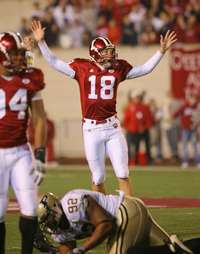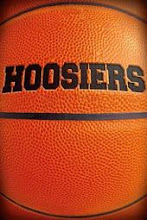Old Oaken Bucket Game - Indiana University vs. Purdue University

Since 1925, each year the Indiana University Hoosiers and Purdue University Boilermakers play a Big Ten conference football game to determine the winner of the Old Oaken Bucket; one of the oldest football trophies in the nation. The Old Oaken Bucket is symbolic of collegiate football supremacy between the two largest public universites in Indiana - the bucket is in it's 83rd year of spirited rivalry. These teams play at the highest level, NCAA Division I.
On Saturday, November 17, I attended my first "bucket game" in person and enjoyed the experience with the company of my son who is a sophmore at Indiana University - Bloomington, and a close friend of mine and his son from Chicago (who are avid Boiler fans).
 The Hoosiers won the contest 27 - 24 with kicker Austin Starr sending a 49-yard game winning field goal squarely between the goal posts with 30 seconds remaining.
The Hoosiers won the contest 27 - 24 with kicker Austin Starr sending a 49-yard game winning field goal squarely between the goal posts with 30 seconds remaining.Earlier in the game Starr had made a 42-yard field goal to set an IU school record for field goals in a season with 18. Ironically, Starr wears jersey #18. "I had a dream this week about me doing this," he said of the game winner. "I'm not sure how long the kick was in my dream, but I prepared myself all week to be the guy to enable us to beat Purdue, to have a game-winning kick."
The weather could have have been more gorgeous; an absolutely beautiful warm sunny, southern Indiana fall day where the afternoon temperature at the 3:30 pm kick-off was 57 degrees, clear skies and no wind. Those from this region know the setting for Indiana football does not get any better than this and Memorial Stadium, with a capacity is 50,180 was sold out.

Accordingly to the Chicago Chapter of the IU Alumni Association, the history of this rivalry began when both institutions, who had met on the field since 1891, held a meeting of the Indiana and Purdue Alumni Chapters of Chicago in 1925 to "discuss the possibility of undertaking worthy joint enterprises in behalf of the two schools."
The creation of a traditional football trophy to go to the winner of the annual clash was proposed. Dr. Clarence Jones of IU and Russell Gray of Purdue were appointed to recommend a suitable trophy.
At a later meeting they recommended "an old oaken bucket" as the most typical Hoosier form of trophy, that the bucket should be taken from a well in Indiana, and a chain to be made of bronze block "I" and "P" letters should be provided for the bucket. The school who wins the traditional football game each years should have possession of the "Old Oaken Bucket" until the next game and should attach the block letter representing the winning school to the bail with the score engraved on the latter link."
Fritz Ernst of Purdue and Indiana's Wiley J. Huddle were givent he task of finding the bucket. They located it on the old Bruner Farm between Kent and Hanover in southern Indiana. The region had been settled by the Bruner family in the 1840's, making today's bucket well over a century old. For the first game, in 1925, excellent repair work put the bucket, moss and mold-covered with some staves showing signs of decay into good shape for its initial appearance, which ended in a 0-0 tie!
I am glad 82 years after the first Old Oaken Bucket game that I was able to enjoy a Hoosier victory! After the win, we all went down onto the field and mixed with the team, students and fans - this was a unique experience that I hope to have again.....


